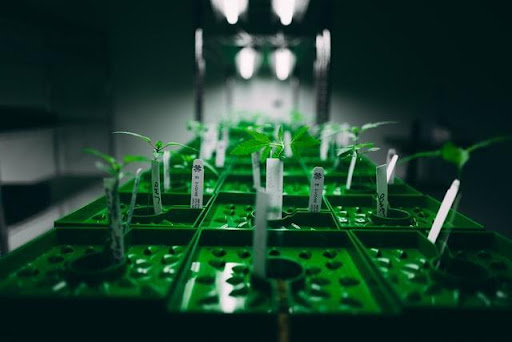
 Loading... Please wait...
Loading... Please wait...Save Money. Grow Your Own!
Fast Plain Box Shipping.
We ship to the US & Canada.
Posted on 9th May 2022

Interest in cannabis is at an unprecedented high, and for good reason. Research into the therapeutic potential of cannabinoids and terpenes has shown that several cannabis compounds — not just THC or CBD — have significant therapeutic potential. The beneficial properties of these compounds are accessible not just in psychoactive varieties of cannabis like marijuana, but for hemp as well.
More seasoned cannabis devotees have taken to growing their own cannabis plants, in a bid to customize their cannabinoid and terpene profiles. This allows for a personalized as-you-want-it approach to the medicinal and therapeutic benefits of cannabis.
Is Growing Hemp Legal?
According to the American Farm Bureau Federation website, hemp production is legal in 46 of 50 states, with Idaho, New Hampshire, Mississippi and South Dakota as notable holdouts. In states where hemp production is legal, industrial producers, home growers and DIYers alike can grow any cannabis sativa l. plant, provided they stay below the legal THC threshold of 0.3 percent.
The private growing of hemp allows consumers an affordable, customizable way to access the therapeutic properties of the cannabis plant — allowing knowledgeable consumers and DIYers even greater control over the production of their own tinctures, concentrates, edibles and vape cartridges.
While most cannabis consumers prefer to simply get their cannabis at local dispensaries or purchase terpenes online from reputable companies making quality products, this is an explainer for more adventurous cannabis enthusiasts. In this post, we go over everything you need to know about using grow lights to grow your own hemp plants; from the best lights for the job to a quick walkthrough of the process.
How Do Grow Lights Work?
In a nutshell, grow lights work by emitting an electromagnetic spectrum that helps plants photosynthesize. This is done by providing light in the red and blue areas of the spectrum, which are the colors that plants need the most to grow.
Many different types of grow lights and lighting systems exist, each with their own advantages and disadvantages. There are two main types of grow lights: high intensity discharge (HID) lights and fluorescent bulbs. HID lights use a highly focused light source to emit the desired light for photosynthesis, whereas fluorescent bulbs tend to spread out the emitted light more than HID lights.
While HID lights last considerably longer than their fluorescent counterparts, the latter certainly isn’t without its share of upsides. For one thing, fluorescent bulbs are inexpensive and easy to replace in comparison to HID lights. Additionally, fluorescent bulbs don’t generate a large amount of heat. This makes them an ideal choice for small scale indoor gardens, or for gardeners who plan on maintaining a smaller number of plants.
Another advantage of fluorescent bulbs is that they come in a wide variety of colors, allowing gardeners to customize the light spectrum emitted by them. For example, if you’re growing tomatoes, you may want to use a fluorescent bulb that emits more blue light so your plants receive enough energy to produce fruits. If you’re growing lettuce, on the other hand, you may want to use a bulb that emits more red light to encourage growth.
Growing The Hemp
The first step in the hemp growth cycle is germination. Start by soaking the seeds for 8-12 hours between 60-70°F. Then plant the seeds at least an inch deep in starter mix, using a heat mat along with a thermostat to track and maintain soil temperature. Depending on the climate in your area, you might need to use a humidifier dome to aid the germination process.
Use high-output T5 HID or fluorescent lights 6 to 10 inches from the seedlings. Keep the lights on 18-24 hours a day, lowering them and adjusting the light cycle depending on how much the seedlings stretch.
When the seedlings have rooted to the extremities of their rooting cells, it’s time to transplant them into four- or five-inch containers with the help of some transplant mix. After transplantation, raise temperature to 70-84°F, with a relative humidity of 45-75%. Lights must be raised to between two to three feet, as the canopy starts to grow taller. Maintaining light cycles at between 18-24 hours keeps the hemp plants in a vegetative state, which is growth without flowering.
After thirty to sixty days of vegetative development, you can transition your plants into their flowering stage by lowering temperatures to between 70-75°F, reducing relative humidity to between 40-50% and drastically altering the light cycle to 12 hours on, 12 hours off. During off hours, the plants must be in complete darkness, so consider using a blackout cover or grow tent if needed.
As you gain experience growing hemp plants with the use of grow lights, you can begin to experiment with light stressing methods such as light pruning, tying or temperature manipulation to increase cannabinoid and terpene yields.